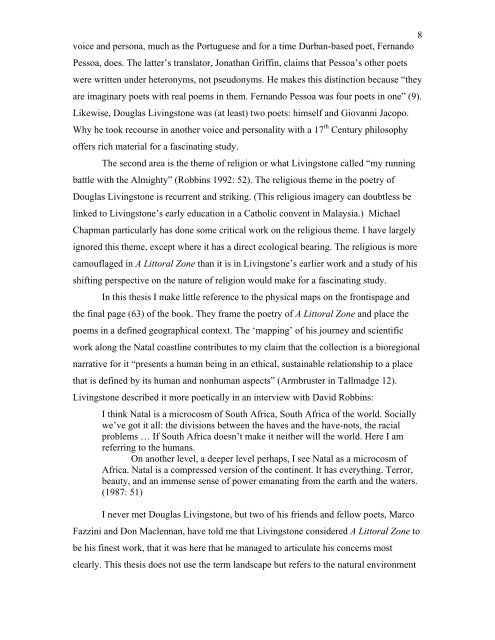"Symbiosis or Death": - Rhodes University
"Symbiosis or Death": - Rhodes University
"Symbiosis or Death": - Rhodes University
Create successful ePaper yourself
Turn your PDF publications into a flip-book with our unique Google optimized e-Paper software.
8<br />
voice and persona, much as the P<strong>or</strong>tuguese and f<strong>or</strong> a time Durban-based poet, Fernando<br />
Pessoa, does. The latter’s translat<strong>or</strong>, Jonathan Griffin, claims that Pessoa’s other poets<br />
were written under heteronyms, not pseudonyms. He makes this distinction because “they<br />
are imaginary poets with real poems in them. Fernando Pessoa was four poets in one” (9).<br />
Likewise, Douglas Livingstone was (at least) two poets: himself and Giovanni Jacopo.<br />
Why he took recourse in another voice and personality with a 17 th Century philosophy<br />
offers rich material f<strong>or</strong> a fascinating study.<br />
The second area is the theme of religion <strong>or</strong> what Livingstone called “my running<br />
battle with the Almighty” (Robbins 1992: 52). The religious theme in the poetry of<br />
Douglas Livingstone is recurrent and striking. (This religious imagery can doubtless be<br />
linked to Livingstone’s early education in a Catholic convent in Malaysia.) Michael<br />
Chapman particularly has done some critical w<strong>or</strong>k on the religious theme. I have largely<br />
ign<strong>or</strong>ed this theme, except where it has a direct ecological bearing. The religious is m<strong>or</strong>e<br />
camouflaged in A Litt<strong>or</strong>al Zone than it is in Livingstone’s earlier w<strong>or</strong>k and a study of his<br />
shifting perspective on the nature of religion would make f<strong>or</strong> a fascinating study.<br />
In this thesis I make little reference to the physical maps on the frontispage and<br />
the final page (63) of the book. They frame the poetry of A Litt<strong>or</strong>al Zone and place the<br />
poems in a defined geographical context. The ‘mapping’ of his journey and scientific<br />
w<strong>or</strong>k along the Natal coastline contributes to my claim that the collection is a bi<strong>or</strong>egional<br />
narrative f<strong>or</strong> it “presents a human being in an ethical, sustainable relationship to a place<br />
that is defined by its human and nonhuman aspects” (Armbruster in Tallmadge 12).<br />
Livingstone described it m<strong>or</strong>e poetically in an interview with David Robbins:<br />
I think Natal is a microcosm of South Africa, South Africa of the w<strong>or</strong>ld. Socially<br />
we’ve got it all: the divisions between the haves and the have-nots, the racial<br />
problems … If South Africa doesn’t make it neither will the w<strong>or</strong>ld. Here I am<br />
referring to the humans.<br />
On another level, a deeper level perhaps, I see Natal as a microcosm of<br />
Africa. Natal is a compressed version of the continent. It has everything. Terr<strong>or</strong>,<br />
beauty, and an immense sense of power emanating from the earth and the waters.<br />
(1987: 51)<br />
I never met Douglas Livingstone, but two of his friends and fellow poets, Marco<br />
Fazzini and Don Maclennan, have told me that Livingstone considered A Litt<strong>or</strong>al Zone to<br />
be his finest w<strong>or</strong>k, that it was here that he managed to articulate his concerns most<br />
clearly. This thesis does not use the term landscape but refers to the natural environment

















